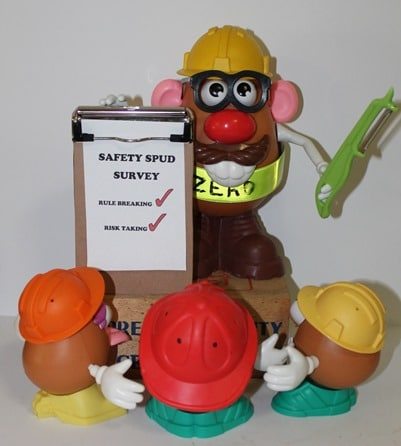Safety Surveys, Bias and Predictability
Rob’s new Book: “Following-Leading in Risk” is a MUST READ if you think you already know about Leadership. CHECK IT OUT
This week Safe Work Australia released a report on Attitudes Towards Risk Taking and Rule Breaking in Australian Workplaces . The report summarizes findings from the Perceptions of Work Health and Safety Survey 2012 for attitudes towards risk taking and rule breaking amongst Australian workers.
The report is based on the Nordic Occupational Safety Climate Questionnaire (NOSACQ-50), a climate survey tool that tells very little about underlying cultural and Australian cultural values towards safety. The survey itself assumes that risk taking is wrong.
Like most orthodox climate surveys, the statements are systemically predictable. The statement set doesn’t assess decision making in the bounds of workplace ambiguity, implicit decision making, work complexity, organizational culture or any form of workplace dissonance. For example:
· I/you accept risk taking at work
· I/you regard risks as unavoidable in the workplace
· I/you never accept risk taking even if the work schedule is tight
· Workers get financial rewards for breaking the rules.
· You are under pressure from workmates to break rules.
· You take short cuts which involve little or no risk.
Well, we all know how to answers these statements, especially if one works in a zero harm climate or an organization with a deficit view of risk.
The results are equally as predictable eg. Apparently in Australia, only 15% of workers accept risk taking at work and 50% of workers never accept risk when the schedule is tight.
As a paper-based survey the NOSACQ-50 assumes that risk decision making is a rational process where one ‘thinks’ about risk. All judgments about risk in the NOSACQ-50 are framed in a rationalist and straight forward manner and assume an honest and open reporting culture. The survey doesn’t consider if a climate of cynicism, scepticism or fear conditions responses and neither are the responses time constrained. So the survey gives no measure of implicit, non-conscious or feeling-based decision making in the organization. Asking for a straightforward response to a predictable statement in a strict regulatory environment is like asking children in school to tell if they cheated.
Whilst the SWA report claims to be just ‘reporting’ what is evident is that the assumptions of the survey presume that risk taking and rule breaking are objectively wrong/bad. However, there is no risk taking that is neutral or objective, all risk taking is situated in a social context. Unless one knows how the social context shapes decision making, particularly under pressure, a survey of individual responses to rationalist statements doesn’t tell you much.
The reality is that most decision making at work is not rational or irrational but non-rational. Many decisions are made under pressure and organizational climate itself affects responses in a paper-based diagnostic.
Humans make non-rational decisions when constrained by time, when affected by social arrangements and rely on heuristics for decision making in the common state of automaticity. When the pressure is on, human decision making is made by implicit not rational knowledge.
Even if the NOSACQ-50 gave a reliable measure of risk decision making, one doesn’t know whether that decision making is healthy, realistic and collectively sense-able. All risk is interpreted, that is the beauty of ALARP. Even if a measure of 50% is accurate, one doesn’t know whether the workers perceive risk as a learning necessity or if risk is perceived pejoratively as the survey assumes. Even if the data from such a survey was accurate, what does this tell you? Do we now hammer all risk taking? Even if the survey was an accurate measure of risk taking attitude, how can this be tackled, more systems and regulation?
A diagnostic that measures underlying cultural values such as cynicism, fatalism, pessimism and scepticism would be far more valuable than the results of this survey. A diagnostic that was able to measure implicit knowledge would be a far better predictor of risk decision making and judgment at work. A diagnostic that measured the social psychology of the workplace would give a far better indicator of what shaped decision making. Then the response can be a leadership response and tackled at a social level not a regulatory, systems level. The NOSACQ-50 primes a ‘management’ rather than a ‘leadership’ approach to risk.
If you want to know more about an alternative approach to measuring risk you can view a video about the MiProfile Survey (http://vimeo.com/24764673) or read a report here. (http://issuu.com/masterbuildersact/docs/cbn3-2012/32)




Do you have any thoughts? Please share them below